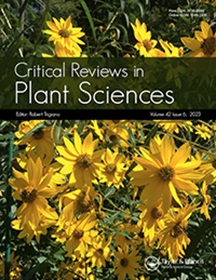Heterosis in Genomic Era: Advances in the Molecular Understanding and Techniques for Rapid Exploitation
IF 6
2区 生物学
Q1 PLANT SCIENCES
引用次数: 5
Abstract
Abstract Heterosis has been widely exploited in plants and animals, and also revolutionized agriculture by improving important agronomic traits. However, the molecular mechanism is still remaining elusive. Though different classical models, viz., dominance, overdominance and epistasis still holds true, the recent studies on epigenomics, transcriptomic, proteomic, metabolomics and circadian model have provided new insights. Multigene models have been proposed as the basis of complementation of allelic and gene expression variation, which is a major probable contributor to heterosis. The evolving epigenetic and genomic field put forward the role of interaction of alleles from different parental genomes in reprogramming the genes involved in stress tolerance, fitness and growth of hybrids. In the majority of the studies, transcriptomic, proteomic and metabolomic studies have found many complex regulatory network changes in genetic, epigenetic, regulatory and biochemical levels and only a few patterns could be established. Thus, heterosis is the outcome of the series of interactions in the genomes. Furthermore, epigenetic modifications of the circadian clock genes and their reciprocal regulators were reported to regulate the expression of downstream genes and pathways leading to more product accumulation in hybrids. Moreover, the majority of the epigenetic studies are limited to Arabidopsis thaliana and Zea mays, however, such studies on different crops may further bring more insights on the role of epigenetic mechanisms in determining heterosis. Further, none of the models is capable to explain heterosis alone which reflects the limitations of the individual model. The present review critically assesses different theories from different fields and also unravels the existing rapid methods to exploit them.基因组时代的杂种优势:分子理解和快速开发技术的进展
摘要杂种优势在动植物中得到了广泛的利用,也通过改善重要的农艺性状而彻底改变了农业。然而,分子机制仍然难以捉摸。尽管不同的经典模型,即显性、超显性和上位性仍然成立,但最近对表观基因组学、转录组学、蛋白质组学、代谢组学和昼夜节律模型的研究提供了新的见解。多基因模型已被提出作为等位基因互补和基因表达变异的基础,这是杂种优势的主要可能因素。进化中的表观遗传学和基因组领域提出了来自不同亲本基因组的等位基因的相互作用在重新编程涉及杂交种的应激耐受、适应性和生长的基因中的作用。在大多数研究中,转录组学、蛋白质组学和代谢组学研究发现,在遗传、表观遗传学、调节和生物化学水平上存在许多复杂的调节网络变化,只有少数模式可以建立。因此,杂种优势是基因组中一系列相互作用的结果。此外,据报道,昼夜节律时钟基因的表观遗传学修饰及其相互调节因子可以调节下游基因的表达和通路,从而在杂交种中积累更多的产物。此外,大多数表观遗传学研究仅限于拟南芥和玉米,然而,对不同作物的此类研究可能会进一步深入了解表观遗传学机制在决定杂种优势中的作用。此外,没有一个模型能够单独解释杂种优势,这反映了单个模型的局限性。本综述批判性地评估了来自不同领域的不同理论,并揭示了现有的快速利用它们的方法。
本文章由计算机程序翻译,如有差异,请以英文原文为准。
求助全文
约1分钟内获得全文
求助全文
来源期刊
CiteScore
12.90
自引率
1.40%
发文量
15
审稿时长
>12 weeks
期刊介绍:
Critical Reviews in Plant Sciences focuses on presenting in-depth and up-to-date reviews of timely and/or cutting-edge subjects in the broad discipline of plant science, ranging from molecular biology/biochemistry through the areas of cell biology, plant pathology and physiology, genetics, classical botany, and ecology, to practical agricultural applications. Articles in the journal provide an up-to-date literature base for researchers and students, pointing the way towards future research needs. The journal is also a significant source of credible, objective information to aid decision makers at all levels.

 求助内容:
求助内容: 应助结果提醒方式:
应助结果提醒方式:


